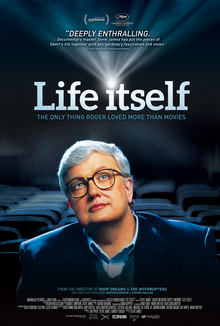
Roger Joseph Ebert was an American film critic, film historian, journalist, essayist, screenwriter, and author. He was a film critic for the Chicago Sun-Times from 1967 until his death in 2013. Ebert was known for his intimate, Midwestern writing voice and critical views informed by values of populism and humanism. Writing in a prose style intended to be entertaining and direct, he made sophisticated cinematic and analytical ideas more accessible to non-specialist audiences. Ebert frequently endorsed foreign and independent films he believed would be appreciated by mainstream viewers, which often resulted in such films receiving greater exposure. In 1975, Ebert became the first film critic to win the Pulitzer Prize for Criticism. Neil Steinberg of the Chicago Sun-Times said Ebert "was without question the nation's most prominent and influential film critic," and Kenneth Turan of the Los Angeles Times called him "the best-known film critic in America."
The Academy Award for Best Documentary Feature Film is an award for documentary films. In 1941, the first awards for feature-length documentaries were bestowed as Special Awards to Kukan and Target for Tonight. They have since been bestowed competitively each year, with the exception of 1946. Copies of every winning film are held by the Academy Film Archive.

Eugene Kal Siskel was an American film critic and journalist for the Chicago Tribune. He is best known for co-hosting various movie review television series with colleague Roger Ebert.
William Gates is an American former basketball player. Gates was the subject of the 1994 documentary film Hoop Dreams with Arthur Agee, another basketball player.
Gene Siskel and Roger Ebert, collectively known as Siskel & Ebert, were American film critics known for their partnership on television lasting from 1975 to Siskel's death in 1999.

Crumb is a 1994 American documentary film about the noted underground cartoonist R. Crumb and his family and his outlook on life. Directed by Terry Zwigoff and produced by Lynn O'Donnell, it won widespread acclaim. It was released on the film festival circuit in September 1994 before being released in the USA on April 28, 1995, having been screened at film festivals that year. Jeffery M. Anderson placed the film on his list of the ten greatest films of all time, labeling it "the greatest documentary ever made." The Criterion Collection released the film on DVD and Blu-ray on August 10, 2010.
Steve James is an American film producer and director of several documentaries, including Hoop Dreams (1994), Stevie (2002), The Interrupters (2011), Life Itself (2014), and Abacus: Small Enough to Jail (2016).

Freida Lee Mock is an American filmmaker, director, screenwriter and producer. She is a co-founder of the American Film Foundation with Terry Sanders. Her documentary, Maya Lin: A Strong Clear Vision (1994) won an Academy Award for Best Feature Documentary in 1995.

James Allan Schamus is an American screenwriter, producer, business executive, film historian, professor, and director. He is a frequent collaborator of Ang Lee, the co-founder of the production company Good Machine, and the co-founder and former CEO of motion picture production, financing, and worldwide distribution company Focus Features, a subsidiary of NBCUniversal. He is currently president of the New York–based production company Symbolic Exchange, and is Professor of Professional Practice at Columbia University, where he has taught film history and theory since 1989.
Arthur Agee Jr. is an American former professional basketball player. He was one of two Chicago-area basketball players whose lives were chronicled in the 1994 documentary Hoop Dreams. Agee played college basketball for the Arkansas State Red Wolves and professionally with the Winnipeg Cyclone of the International Basketball Association.

St. Joseph High School was a Roman Catholic, coeducational, college prep school in Westchester, Illinois, and was sponsored by the De La Salle Christian Brothers.
Kartemquin Films is a four-time Oscar-nominated 501(c)3 non-profit production company located in Chicago, Illinois, that produces a wide range of documentary films. It is the documentary filmmaking home of acclaimed producers such as Gordon Quinn, Steve James, Peter Gilbert, Maria Finitzo, Joanna Rudnick, Bing Liu, Aaron Wickenden, and Ashley O’Shay (Unapologetic).
John Marshall Metropolitan High School is a public 4–year high school located in the East Garfield Park neighborhood on the west side of Chicago, Illinois, United States. Opened in 1895, Marshall is operated by the Chicago Public Schools district. Marshall is named in honor of John Marshall, the fourth Chief Justice of the Supreme Court of the United States. Marshall serves the students of the East Garfield Park, West Garfield Park, North Lawndale and Humboldt Park neighborhoods.

The Interrupters is a 2011 documentary film, produced by Kartemquin Films, that tells the story of three violence interrupters who try to protect their Chicago communities from the violence they once employed. It examines a year in which Chicago drew national headlines for violence and murder that plagued the city.

Frederick Marx is a film producer/director/writer. He was named a Chicago Tribune Artist of the Year for 1994, a 1995 Guggenheim Fellow, and a recipient of a Robert F. Kennedy Special Achievement Award. Frederick Marx achieved international fame for co-writing the film Hoop Dreams with Steve James, the director of the film. It is one of the highest grossing non-musical documentaries in United States history.

Ira Deutchman is a producer, distributor and marketer of independent films. In 2000, he moved into film exhibition as co-founder and managing partner of Emerging Pictures, a New York-based digital exhibition company, which was sold in January 2015 to Vancouver-based 20 Year Media. He also served as Chair of the Film Program at Columbia University School of the Arts from 2011 to 2015, where he has been a Professor since 1987. Deutchman is a member of The Academy of Motion Picture Arts and Sciences. He was one of the original creative advisors to the Sundance Institute and formerly served on the board of advisors for the Sundance Film Festival. He has also served as a board member and former board chair for the Independent Feature Project, the board of advisors for the Los Angeles Independent Film Festival, the Williamstown Film Festival, IFP/West, and the Collective for Living Cinema, and was a member of the board for Kartemquin Films.

Life Itself is a 2014 American biographical documentary film about Chicago film critic Roger Ebert, directed by Steve James and produced by Zak Piper, James and Garrett Basch. The film is based on Ebert's 2011 memoir of the same name. It premiered at the 2014 Sundance Film Festival and was an official selection at the 67th Cannes Film Festival. The 41st Telluride Film Festival hosted a special screening of the film on August 28, 2014. Magnolia Pictures released the film theatrically in the United States and simultaneously via video on demand platforms on July 4, 2014.

Dick Johnson Is Dead is a 2020 American documentary film directed by Kirsten Johnson and co-written by Johnson and Nels Bangerter. The story focuses on Johnson's father Richard, who suffers from dementia, portraying different ways—some of them violent "accidents"—in which he could ultimately die. In each scenario, the elderly Johnson plays along with his daughter's black humor and imaginative fantasies. The film premiered at the 2020 Sundance Film Festival, where it won the Special Jury Award for Innovation in Non-fiction Storytelling. It was released on Netflix on October 2, 2020.
Eugene Louis Pingatore was an American basketball coach who served as the head boys' basketball coach at St. Joseph High School in Westchester, Illinois, a suburb of Chicago. In 50 seasons as head coach at St. Joseph, he compiled a record of 1,035–383—the most wins of any Illinois high school basketball coach—and led his teams to two Illinois High School Boys Basketball Championships, in 1999 and 2015. In the late 1970s, Pingatore mentored Isiah Thomas, who went on to star in college basketball for the Indiana Hoosiers and in the National Basketball Association (NBA) for the Detroit Pistons. Pingatore was also featured in the 1994 documentary film Hoop Dreams, which followed the lives of William Gates and Arthur Agee, who played for Pingatore at St. Joseph.
Peter Gilbert is an American documentary filmmaker. He was the cinematographer and one of the producers of Hoop Dreams, a 1994 documentary about two teenage basketball players in Chicago. He has worked on several films for Kartemquin Films, including Vietnam, Long Time Coming, At the Death House Door, and In the Game. He was nominated for a Primetime Emmy for Exceptional Merit In Nonfiction Filmmaking in 2005 for producing With All Deliberate Speed, a documentary about Brown v. Board of Education. Prior to Hoop Dreams, he worked on the cinematography of American Dream by Barbara Kopple, and with Haskell Wexler. He is a member of the Academy of Motion Picture Arts and Sciences.











